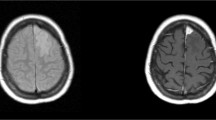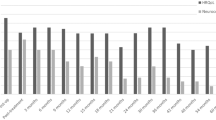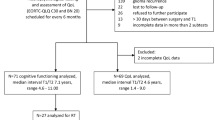Abstract
Few data are available concerning the neurocognitive outcome and health-related quality of life (HRQOL) following neurosurgery in meningioma patients, and even less is known about neurocognitive functioning and HRQOL in untreated patients with stable lesions. The present study aims at quantifying the nature and extent of neurocognitive deficits and HRQOL in suspected WHO grade I meningioma patients who have not received surgery and/or radiotherapy and compare outcome to that of healthy controls. Neurocognitive functioning was assessed by using a standardized test battery in 21 radiologically suspected WHO grade I meningioma patients with a wait-and-scan approach. HRQOL was assessed with the MOS SF-36 questionnaire. These patients were matched for age, sex, and education with 21 healthy controls. Associations between neurocognitive functioning on the one hand and HRQOL and tumor characteristics on the other were determined. Compared to healthy controls, meningioma patients had lower psychomotor speed (p = 0.011) and working memory capacity (p = 0.034) and furthermore attained lower levels of self-perceived general health and vitality. Neurocognitive functioning in untreated patients was not related to tumor volume, edema or tumor lateralization. No correlations were found between psychomotor speed or working memory and HRQOL. Untreated meningioma patients with stable lesions have limitations in neurocognitive functioning and HRQOL. In deciding upon a treatment strategy these reductions in functioning should be taken into consideration and communicated with the patient.
Similar content being viewed by others
References
Longstreth WT Jr, Dennis LK, McGuire VM, Drangsholt MT, Koepsell TD (1993) Epidemiology of intracranial meningioma. Cancer 72:639–648
Radhakrishnan K, Mokri B, Parisi JE, O’Fallon WM, Sunku J, Kurland LT (1995) The trends in incidence of primary brain tumors in the population of Rochester, Minnesota. Ann Neurol 37:67–73
Tabernero MD, Espinosa AB, Maillo A, Rebelo O, Vera JF, Sayagues JM, Merino M, Diaz P, Sousa P, Orfao A (2007) Patient gender is associated with distinct patterns of chromosomal abnormalities and sex chromosome linked gene-expression profiles in meningiomas. Oncologist 12:1225–1236
Whittle IR, Smith C, Navoo P, Collie D (2004) Meningiomas. Lancet 363:1535–1543
Wiemels J, Wrensch M, Claus EB (2010) Epidemiology and etiology of meningioma. J Neurooncol 99:307–314
Nakamura M, Roser F, Michel J, Jacobs C, Samii M (2003) The natural history of incidental meningiomas. Neurosurgery 53:62–70
Nakasu S, Hirano A, Shimura T, Llena JF (1987) Incidental meningiomas in autopsy study. Surg Neurol 27:319–322
Vernooij MW, Ikram MA, Tanghe HL, Vincent AJ, Hofman A, Krestin GP, Niessen WJ, Breteler MM, van der Lugt A (2007) Incidental findings on brain MRI in the general population. N Engl J Med 357:1821–1828
Dijkstra M, van Nieuwenhuizen D, Stalpers LJ, Wumkes M, Waagemans M, Vandertop WP, Heimans JJ, Leenstra S, Dirven CM, Reijneveld JC, Klein M (2009) Late neurocognitive sequelae in patients with WHO grade I meningioma. J Neurol Neurosurg Psychiatry 80:910–915
van Nieuwenhuizen D, Klein M, Stalpers LJ, Leenstra S, Heimans JJ, Reijneveld JC (2007) Differential effect of surgery and radiotherapy on neurocognitive functioning and health-related quality of life in WHO grade I meningioma patients. J Neurooncol 84:271–278
Klein M, Heimans JJ, Aaronson NK, van der Ploeg HM, Grit J, Muller M, Postma TJ, Mooij JJ, Boerman RH, Beute GN, Ossenkoppele GJ, van Imhoff GW, Dekker AW, Jolles J, Slotman BJ, Struikmans H, Taphoorn MJ (2002) Effect of radiotherapy and other treatment-related factors on mid-term to long-term cognitive sequelae in low-grade gliomas: a comparative study. Lancet 360:1361–1368
Saloner D, Uzelac A, Hetts S, Martin A, Dillon W (2010) Modern meningioma imaging techniques. J Neurooncol 99:333–340
Aaronson NK, Muller M, Cohen PD, Essink-Bot ML, Fekkes M, Sanderman R, Sprangers MA, Te VA, Verrips E (1998) Translation, validation, and norming of the Dutch language version of the SF-36 health survey in community and chronic disease populations. J Clin Epidemiol 51:1055–1068
Jolles J, van Boxtel MP, Ponds RW, Metsemakers JF, Houx PJ (1998) The Maastricht aging study (MAAS). The longitudinal perspective of cognitive aging. Tijdschr Gerontol Geriatr 29:120–129
der Elst Van, Van Boxtel MP, Van Breukelen GJ, Jolles J (2006) Normative data for the animal, profession and letter M Naming verbal fluency tests for Dutch speaking participants and the effects of age, education, and sex. J Int Neuropsychol Soc 12:80–89
der Elst Van, Van Boxtel MP, Van Breukelen GJ, Jolles J (2006) The concept shifting test: adult normative data. Psychol Assess 18:424–432
der Elst Van, van Boxtel MP, van Breukelen GJ, Jolles J (2006) The letter digit substitution test: normative data for 1,858 healthy participants aged 24–81 from the Maastricht aging study (MAAS): influence of age, education, and sex. J Clin Exp Neuropsychol 28:998–1009
der Elst Van, Van Boxtel MP, Van Breukelen GJ, Jolles J (2006) The Stroop color-word test: influence of age, sex, and education; and normative data for a large sample across the adult age range. Assessment 13:62–79
der Elst Van, van Boxtel MP, van Breukelen GJ, Jolles J (2005) Rey’s verbal learning test: normative data for 1855 healthy participants aged 24–81 years and the influence of age, sex, education, and mode of presentation. J Int Neuropsychol Soc 11:290–302
der Elst Van, Van Boxtel MP, Van Breukelen GJ, Jolles J (2007) Assessment of information processing in working memory in applied settings: the paper and pencil memory scanning test. Psychol Med 37:1335–1344
Klein M, Engelberts NH, van der Ploeg HM, Kasteleijn-Nolst Trenite DG, Aaronson NK, Taphoorn MJ, Baaijen H, Vandertop WP, Muller M, Postma TJ, Heimans JJ (2003) Epilepsy in low-grade gliomas: the impact on cognitive function and quality of life. Ann Neurol 54:514–520
Brazil L, Thomas R, Laing R, Hines F, Guerrero D, Ashley S, Brada M (1997) Verbally administered Barthel Index as functional assessment in brain tumour patients. J Neurooncol 34:187–192
Sachsenheimer W, Piotrowski W, Bimmler T (1992) Quality of life in patients with intracranial tumors on the basis of Karnofsky’s performance status. J Neurooncol 13:177–181
Order SE, Hellman S, Von Essen CF, Kligerman MM (1968) Improvement in quality of survival following whole-brain irradiation for brain metastasis. Radiology 91:149–153
Osoba D, Aaronson NK, Muller M, Sneeuw K, Hsu MA, Yung WK, Brada M, Newlands E (1996) The development and psychometric validation of a brain cancer quality-of-life questionnaire for use in combination with general cancer-specific questionnaires. Qual Life Res 5:139–150
Shen C, Bao WM, Yang BJ, Xie R, Cao XY, Luan SH, Mao Y (2012) Cognitive deficits in patients with brain tumor. Chin Med J (Engl) 125:2610–2617
Tucha O, Smely C, Lange KW (2001) Effects of surgery on cognitive functioning of elderly patients with intracranial meningioma. Br J Neurosurg 15:184–188
Tucha O, Smely C, Preier M, Becker G, Paul GM, Lange KW (2003) Preoperative and postoperative cognitive functioning in patients with frontal meningiomas. J Neurosurg 98:21–31
Steinvorth S, Welzel G, Fuss M, Debus J, Wildermuth S, Wannenmacher M, Wenz F (2003) Neuropsychological outcome after fractionated stereotactic radiotherapy (FSRT) for base of skull meningiomas: a prospective 1-year follow-up. Radiother Oncol 69:177–182
Tucha O, Smely C, Preier M, Lange KW (2000) Cognitive deficits before treatment among patients with brain tumors. Neurosurgery 47:324–333
Correa DD, Shi W, Thaler HT, Cheung AM, Deangelis LM, Abrey LE (2008) Longitudinal cognitive follow-up in low grade gliomas. J Neurooncol 86:321–327
Reijneveld JC, Sitskoorn MM, Klein M, Nuyen J, Taphoorn MJ (2001) Cognitive status and quality of life in patients with suspected versus proven low-grade gliomas. Neurology 56:618–623
Ruge MI, Ilmberger J, Tonn JC, Kreth FW (2011) Health-related quality of life and cognitive functioning in adult patients with supratentorial WHO grade II glioma: status prior to therapy. J Neurooncol 103:129–136
Bosma I, Douw L, Bortolomei F, Heimans JJ, van Dijk BW, Postma TJ, Stam CJ, Reijneveld JC, Klein M (2008) Synchronized brain activity and neurocognitive function in patients with low-grade glioma: a magnetoencephalography study. Neuro Oncol 10:734–744
Bosma I, Reijneveld JC, Klein M, Douw L, van Dijk BW, Heimans JJ, Stam CJ (2009) Disturbed functional brain networks and neurocognitive function in low-grade glioma patients: a graph theoretical analysis of resting-state MEG. Nonlinear Biomed Phys 3:9
van Dellen E, Douw L, van Dellen E, Douw L, Hillebrand A, Ris-Hilgersom IHM, Schoonheim MM et al (2012) MEG network differences between low- and high-grade glioma related to epilepsy and cognition. PLoS One 7(11):e50122
van Dellen E, de Witt Hamer PC, Douw L, Klein M, Heimans JJ, Stam CJ, Reijneveld JC, Hillebrand A (2012) Connectivity in MEG resting-state networks increases after resective surgery for low-grade glioma and correlates with improved cognitive performance. Neuroimage 2:1–7
de Fockert JW, Rees G, Frith CD, Lavie N (2001) The role of working memory in visual selective attention. Science 291:1803–1806
Waagemans ML, van Nieuwenhuizen D, Dijkstra M, Wumkes M, Dirven CM, Leenstra S, Reijneveld JC, Klein M, Stalpers LJ (2011) Long-term impact of cognitive deficits and epilepsy on quality of life in patients with low-grade meningiomas. Neurosurgery 69:72–78
Conflict of interest
The authors declare that they have no conflict of interest.
Author information
Authors and Affiliations
Corresponding author
Additional information
D. van Nieuwenhuizen and N. Ambachtsheer contributed equally to this work.
Rights and permissions
About this article
Cite this article
van Nieuwenhuizen, D., Ambachtsheer, N., Heimans, J.J. et al. Neurocognitive functioning and health-related quality of life in patients with radiologically suspected meningiomas. J Neurooncol 113, 433–440 (2013). https://doi.org/10.1007/s11060-013-1132-4
Received:
Accepted:
Published:
Issue Date:
DOI: https://doi.org/10.1007/s11060-013-1132-4




